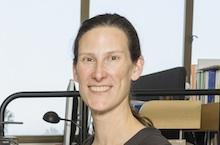ME Seminar on "Legged Locomotion: Analysis, Planning, and Control"
Events | Mechanical Engineering
ME Seminar on "Legged Locomotion: Analysis, Planning, and Control"
February 9, 2015 7:30 AM

Speaker
Professor Katie Byl, Electrical & Computer Engineering, UC Santa Barbara
Location
ESB 1001
Type
Seminar
Abstract
A practical motivation for developing legged systems is to enable agile locomotion in environments with variable terrain and limited foothold availability. A variety of challenges also make legged system control a rich field for academic study. For example, legged systems use intermittent contacts to generate external forces; there is potential to exploit passive dynamics and internal degrees of freedom; mobile systems are subject to noisy information and time-varying environments; and increasing the dimensionality of such systems produces the complementary effects of potentially improving performance while simultaneously making analysis of such "improvements" inherently more challenging to quantify.
In this talk, we discuss work at UCSB on one-legged (hopping), two-legged (biped walking) and four-legged (RoboSimian) robot models. Each system facilitates its own contribution toward agile and robust legged mobility. We highlight work on reachability-based control for underactuated hopping, quantification and optimization of robustness of biped walking, and various techniques for planning dexterous and dynamic motions with RoboSimian, a dexterous, four-limbed robot developed by JPL for the DARPA Robotics Challenge.
Bio
Katie Byl received her B.S., M.S., and Ph.D. degrees in mechanical engineering from MIT. Her research is in dynamic systems and control, with particular interest in modeling and control techniques to deal with the challenges of underactuation, stochasticity, and dimensionality reduction that characterize bio-inspired robot locomotion and manipulation in real-world environments. She is the recipient of an NSF CAREER award (2013), a Hellman Foundation Fellowship (2012), and an Alfred P. Sloan Research Fellowship in Neuroscience (2011). Katie has worked on a wide range of research topics in the control of dynamic systems, including magnetic bearing control, flapping-wing microrobotics, piezoelectic noise cancellation for aircraft, and vibration isolation for gravity wave detection, and she was once a professional gambler on the now-infamous MIT Blackjack Team.